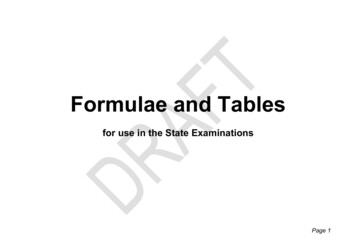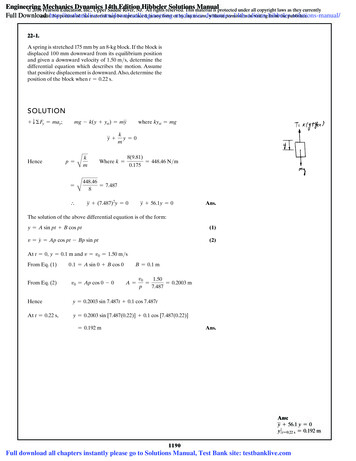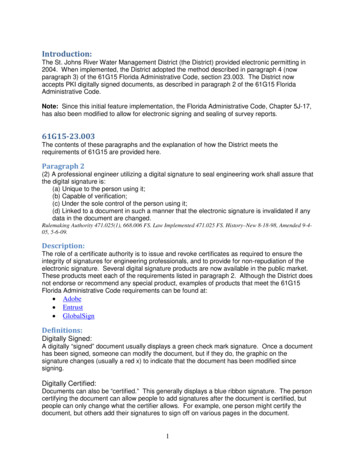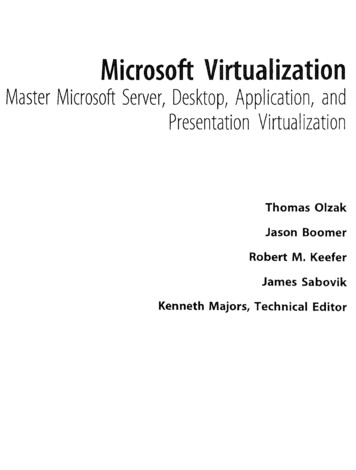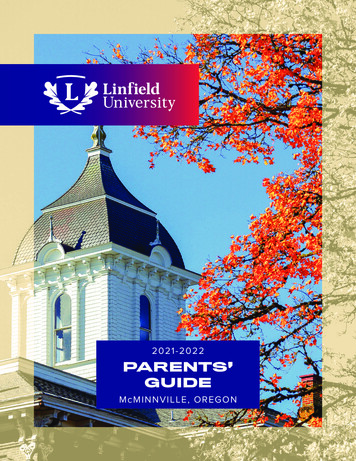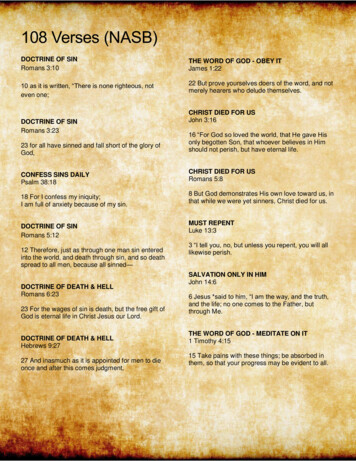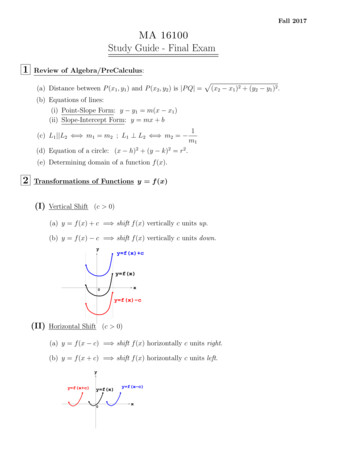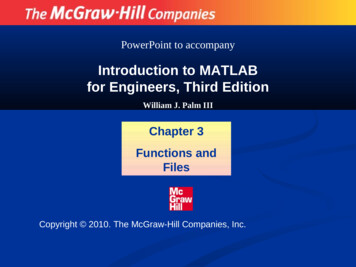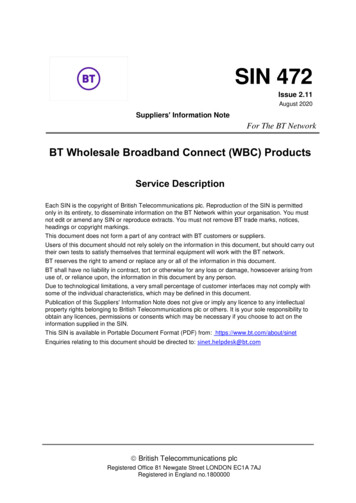
Transcription
SIN 472Issue 2.11August 2020Suppliers' Information NoteFor The BT NetworkBT Wholesale Broadband Connect (WBC) ProductsService DescriptionEach SIN is the copyright of British Telecommunications plc. Reproduction of the SIN is permittedonly in its entirety, to disseminate information on the BT Network within your organisation. You mustnot edit or amend any SIN or reproduce extracts. You must not remove BT trade marks, notices,headings or copyright markings.This document does not form a part of any contract with BT customers or suppliers.Users of this document should not rely solely on the information in this document, but should carry outtheir own tests to satisfy themselves that terminal equipment will work with the BT network.BT reserves the right to amend or replace any or all of the information in this document.BT shall have no liability in contract, tort or otherwise for any loss or damage, howsoever arising fromuse of, or reliance upon, the information in this document by any person.Due to technological limitations, a very small percentage of customer interfaces may not comply withsome of the individual characteristics, which may be defined in this document.Publication of this Suppliers' Information Note does not give or imply any licence to any intellectualproperty rights belonging to British Telecommunications plc or others. It is your sole responsibility toobtain any licences, permissions or consents which may be necessary if you choose to act on theinformation supplied in the SIN.This SIN is available in Portable Document Format (PDF) from: https://www.bt.com/about/sinetEnquiries relating to this document should be directed to: sinet.helpdesk@bt.com British Telecommunications plcRegistered Office 81 Newgate Street LONDON EC1A 7AJRegistered in England no.1800000
1.2.3.4.5.6.CONTENTSINTRODUCTION . 41.1DEFINITIONS. 41.2THIS SIN. 4PRODUCT HANDBOOK . 5END USER ACCESS (EUA) . 63.1GENERAL . 63.2WBC ADSL2 . 63.2.1Line Negotiation . 63.2.2Line rates – service speed up and downstream . 63.2.3Dynamic Line Management (DLM) . 73.2.4ADSL CPE . 93.3FIBRE ACCESS . 103.3.1FTTP CPE . 113.4PPP LAYER. 113.5PPP LAYER ASPECTS . 113.5.1PPPoE Aspects . 123.6USE OF IDS. 123.6.1Service Identifier (SID) . 123.6.2User names . 123.7OAM . 123.8TEST USER ACCOUNT. 123.9EUA INTERACTIONS VIA AGGREGATION POINT E.G. TAGS TERMINATIONS . 12WBC END USER HANDOVER. 144.1INTRODUCTION . 144.2L2TP HANDOVER. 144.3PPPOE AND WBC L2TP PASS THROUGH (FOR INFORMATION) . 144.4PPP TERMINATION AND AGGREGATION (PTA) . 154.4.1Introduction . 154.4.2End User IP Layer . 154.4.3IPv4 address support for PTA . 154.4.4IPv6 address support for PTA End Users . 164.4.5Session Terminations . 174.4.6Customer Responsibilities . 17AGGREGATION POINT (AP) & EXTENSION PATHS (EPS) . 185.1INFRASTRUCTURE IP ADDRESSING . 185.1.1Introduction . 185.1.2BRAS to Broadband Edge Aggregator (BEA) IP Addressing . 185.1.3BEA to WBC Customer IP Addressing. 195.1.4B-RAS Loopback addressing . 195.2ADDRESS SUMMARISATION . 205.3AP & EP ROUTE LIMITS . 215.4ASYMMETRIC ROUTING . 215.5POLICY BASED ROUTING FOR PTA CUSTOMERS . 215.6BEST EFFORTS TRAFFIC CLASSES . 225.7REAL TIME QOS SERVICE . 225.8PACKET MARKINGS . 235.9EXTENSION PATH (EP) . 235.9.1Network Terminating Equipment (NTE) . 235.9.2CP equipment. 235.9.3BGP . 245.9.4Session Based Load Balancing . 255.9.5Frame sizes . 255.9.6EP Policing . 255.10 RESILIENCE UNDER CATASTROPHIC NODE FAILURE . 25RADIUS PROTOCOL & DNS . 276.1GENERAL . 27SIN 472 Issue 2.11 British Telecommunications plcPage 2 of 53
6.2RADIUS AUTHENTICATION . 276.3RADIUS ACCOUNTING . 326.4RADIUS CLIENT . 346.5DNS . 347.REFERENCES . 368.ABBREVIATIONS . 389.HISTORY. 41ANNEX A – WARNING REGARDING THROUGHPUT LIMITATION IMPOSED DUE TO RWINSETTINGS AND INCREASED LATENCY. . 46ANNEX B FLEX POSI . 47ANNEX C – TV CONNECT. 52INTRODUCTION . 52ONBOARDING FOR TV CONNECT . 52TV CONNECT CHANNEL TYPES . 52IMPACT ON EXISTING WBC COMPONENTS . 53WBC End User Access Component . 53QOS in relation to WBC . 53Test & Diagnostics . 53Figure 1. PPP Stages for WBC . 11Figure 2. TV Connect service architecture . 52Table 1 – WBC Data Rates for DSL services . 7Table 2 - End User CPE Parameters . 10Table 3 - Sample BRAS to BEA1 VLAN Interface Addressing Override . 18Table 4 - Sample BRAS to BEA2 VLAN Interface Addressing Override . 19Table 5 - Sample MSE VLAN Interface Addressing Override . 19Table 6 - Sample BEA to WBC Customer VLAN Interface Addressing for EP1 and EP2 . 19Table 7 - Sample BEA to WBC Customer VLAN Interface Addressing for EP3 and EP4 . 19Table 8 - Sample BRAS Loopback Addressing Override . 20Table 9 - BRAS Loopback Addressing . 20Table 10 - MSE Loopback Addressing . 20Table 11 – DSCP code points . 23Table 12 - Packet type id . 27Table 13 – Access-Reject Attributes . 28Table 14 - PTA Access-Accept Attributes . 30Table 15 – L2TP Access-Accept Attributes . 31Table 16 - Accounting Attributes . 33SIN 472 Issue 2.11 British Telecommunications plcPage 3 of 53
1.Introduction1.1 DefinitionsWBC Customer: The Legal Entity who purchases the WBC service from BT and sells or provides it toEnd Users (EUs). Also referred to as Communications Provider (CP) and Internet Service Provider(ISP).End User: The person wishing to connect to an IP network via the WBC service.The document will refer to ADSL as the following:ADSLITU-T Recommendation G.992.1[1]ADSL2ITU-T Recommendation G.992.3[2]ADSL2plusITU-T Recommendation G.992.5[3]ADSL2plus Annex MITU-T Recommendation G.992.5[3]FTTPITU-T Recommendation G.984 series1.2 This SINThis Suppliers’ Information Note (SIN) provides service description information about WBC and itsrelated components, End User Accesses (EUAs), Aggregation Points (APs) and Extensions Paths(EPs) for use by BT and WBC Customers.This SIN should be read in conjunction with SIN 346[20] detailing BT’s G.DMT interface.Documentation specific to the Openreach GEA Product that forms the access part of the WBC overFTTP offering can be found in SIN 506. Current editions of BT’s SINs are available athttps://www.bt.com/about/sinetFor a brief service description of the TV Connect option, please refer to ANNEX C. For furthertechnical information about TV Connect, please refer to the TV Connect SIN 511 available athttps://www.bt.com/about/sinetFurther information is available by reading the Customer RequestForms (CRF) developed for the service - these can be found r further information on the commercial aspects of this service, please refer to: Your BT National Account Manager BT Broadband Helpdesk via e-mail to: broadband.enquiries@bt.com BT Broadband Helpdesk on 0800 0283663 ADSL website http://www.btwholesale.com Broadband community BT Wholesale website http://www.btwholesale.com BT Terms website http://www.bt.com/terms WBC website ata/broadband/wholesale-broadband-connect.htmlIf you have inquiries relating to this document, then please contact: sinet.helpdesk@bt.comSIN 472 Issue 2.11 British Telecommunications plcPage 4 of 53
2.Product HandbookFor a description of the WBC service please see the Wholesale Broadband Connect OperationalHandbook lhandbook.pdf)SIN 472 Issue 2.11 British Telecommunications plcPage 5 of 53
3.End User Access (EUA)3.1 GeneralWBC supports a range of End User Access variants as follows: ADSL2 FTTP FTTC (VDSL) FTTC (G.fast) SOGEA (VDSL) SOGEA (G.fast)See following sections for details of each option in 3.2 and 3.3.3.2 WBC ADSL2 Openreach provide a copper line with an NTE box.The WBC Customer or end user provides an ADSL filter which plugs into the NTE and anADSL/ADSL2plus compatible CPE (i.e. an ADSL/ADSL2plus modem or router) which should complywith this SIN, in order to interoperate successfully with the WBC service. This SIN is published to helpWBC Customers and suppliers of CPE devices to develop their offerings for these products.The WBC ADSL2 product will only be available in conjunction with a WLR line provided byOpenreach.End Users can only receive a single Broadband Service over each WLR line.If the WLR service is ceased then the WBC service will also be ceased.The WBC ADSL2 Annex M service offers the possibility of greater upstream line rates by sacrificingsome downstream line rate. This will require ADSL2 Annex M compatible CPE for the service towork. As the primary purpose of the service is to allow greater upstream bandwidth the performancetester will allow the testing of upstream throughput for Annex M service lines. In all other respectsapart from the upstream and downstream line rates the service will work as standard WBC ADSL2 .3.2.1 Line NegotiationWBC ADSL2 exchange equipment will auto sense between ADSL1, ADSL2, and ADSL2plusdepending on the End User’s CPE. Note that if “ADSL” is selected on the CRF then the line will nottrain up using ADSL2 or ADSL2plus.3.2.2 Line rates – service speed up and downstreamThe following table gives a comparison of data rates of the ADSL products discussed within this SIN:WBC 8Mbit/sADSL1 orADSL2/2PlusWBC 24Mbit/sADSL 2 Downstream LineSpeedUpstream LineSpeed standardproductUpstream LineSpeed uncappedproductDSL linerate (kbit/s)Adaptive 288(1)–8128 kbit/sAdaptive64-448 kbit/sAdaptive64 kbit/s –1280Kbit/sATMpayloadrate (kbit/s)Adaptive260 -7361 kbit/sAdaptive 57405 kbit/sAdaptive57 kbit/s –1159kbit/sDSL linerate (kbit/s)Adaptive 288(1)–24384 kbit/sAdaptive64-448 kbit/sAdaptive64 kbit/s –1280kbit/sSIN 472 Issue 2.11 British Telecommunications plcPage 6 of 53
(ADSL2plusAnnex A)ATMpayloadrate (kbit/s)Adaptive260 -22083 kbit/sWBC 24Mbit/sADSL2 DSL linerate (kbit/s)Adaptive 288 –24384 kbit/sAdaptive 64 kbit/s– uncapped(Note 2)ATMpayloadrate (kbit/s)Adaptive 260 –22083 kbit/sAdaptive 57 kbit/s- uncappedAdaptive 57405 kbit/sAnnex MAdaptive57 kbit/s –1159kbit/sTable 1 – WBC Data Rates for DSL servicesNote 1A line can Rate Adapt down to 160 kbit/s but BT will only support lines able to work stablyat 288 kbit/s and above.Note 2In practice Annex M will give line upstream rates from 64 kbit/s up to approximately2.5Mbit/s (if the end user is very close to the exchange). In addition, if interleaving isenabled then there is a maximum upstream rate limit imposed within the ITURecommendation (G.992.5) of around 1.8Mbit/s (see section 3.2.3.2 for more details).A Fixed Rate product variant is available for the WBC ADSL2 Annex A product. The fixed rates (DSLline rates) are 576kbit/s, 1152kbit/s and 2272kbit/s downstream. The upstream rate for the 576kbit/sdownstream product is rate adaptive from 64kbit/s to 288kbit/s. The upstream rate for the 1152kbit/sand 2272kbit/s downstream products is fixed at 288kbit/s. The Fixed Rate product variant is notavailable for ADSL2 Annex M.The ATM payload rate is defined as the rate available for the transport of IP packets in the payload ofATM cells; note however that each IP packet will incur ATM adaptation layer, PPPoA/oEoA andencapsulation layer overheads. The maximum IP throughput rate that can actually be achieved willhence vary considerably depending upon the IP packet size. No allowance is required for theoverhead introduced by the ATM layer, as this has already been taken into account in these figures.3.2.3 Dynamic Line Management (DLM)3.2.3.1GeneralDLM enables the 'tuning' of a line's performance to ultimately provide an improvement in the level ofservice delivered to the end user. Historical performance data will be gathered periodically fromlines and this will be used to identify those which are performing badly. These lines will then be reconfigured automatically (if possible) to give an improvement in their overall ADSL performance andstability. This re-configuration will result in a short break (typically 20 seconds) in end user service.It is possible that re-configuration of a line could occur daily until a stable configuration is foundalthough it is expected that the majority of poorly performing lines will only require 1 (one) to 2 (two)re-configurations before reaching a stable point.The DLM process may result in a decrease in line rate, but this will only occur where a line isidentified as performing badly at a higher rate. DLM will also use interleaving (see sec. 3.2.3.2 below)to fix problem lines (unless the WBC Customer has opted out of Interleaving for these lines), and thiswill result in an increase in the delay over the connection, which may affect some delay sensitiveservices (e.g. gaming, Video, VoIP).Notification to the customer (via Broadband Customer Reports ) will be provided whenever a changeis made as part of the DLM process. The DLM process (or reset) may also be applied manually aspart of the standard repair process following an end user fault report.DLM works within the rate bounds of the chosen WBC EUA option.Note that the Fixed Rate product variants will not utilise DLM.SIN 472 Issue 2.11 British Telecommunications plcPage 7 of 53
3.2.3.2InterleavingInterleaving is a standard feature of BT’s CMSANs, and part of the ADSL standards:ADSLITU-T Recommendation G.992.1[1]ADSL2ITU-T Recommendation G.992.3[2]ADSL2plusITU-T Recommendation G.992.5[3]Interleaving can be enabled on any individual line to improve its overall (error) performance andstability. Interleaving introduces error correction algorithms, which in some cases can make thedifference between a line working well or not at all. In addition, interleaving may provide a significantimprovement in the quality of service experienced by the end user particularly for error sensitiveservices like video.Interleaving may be applied to individual lines automatically by the DLM function and may be usedwhere a line is identified as suboptimal. BT’s interleaving implementation will increase the delay overthe Broadband connection which can affect some delay sensitive services like gaming.It is possible to opt-out of allowing BT to apply interleaving automatically as part of the DLM processor on an individual line basis at or after the time of order. BT may however temporarily applyinterleaving during the repair process to see if it could improve service.If a line has not been “opted out” and BT has applied interleaving, a Modify Order facility via the BTordering systems will allow a WBC Customer to “opt out” the line at any time. This will have the effectof removing the interleaving on that line and prevents BT permanently applying interleaving in thefuture. WBC Customers should consider carefully before selecting this ‘opt-out’ option, sinceinterleaving offers the potential of significant improvements to end user service. Without usinginterleaving to stabilise a line, other methods may be used, which could lead to a reduction of theachievable line rate.For ADSL2 and ADSL2plus services DLM can control the minimum INP (Impulse Noise Protection)value that can be set. This controls the amount of data corruption that the error correction routines areable to repair and as such can trade data rate for protection. Currently we have a limitation on someof our equipment not supporting an optional set of interleaving parameters which means the use ofsome INP values can cause the achievable rate to drop very quickly with greater effect on the higherrates.For Annex M lines the framing limitations imposed within the standard (see below) mean that themaximum achievable upstream rate will be limited to around 1.8Mbit/s when interleaving is enabled.This limitation has no effect for non-Annex M lines.The effects of the min INP value where only the mandatory set of framing parameters are supportedare shown in the following tables within the ITU-T ADSL2 and ADSL2plus standards documents.For the ADSL2 constraints of only mandatory framing parameter support (within ITU-T G.992.3standards document): Table K.3a/G.992.3- Maximum downstream net data rate (kbit/s) for various valuesof delay min delay max and INP min and Table K.3b/G.992.3 - Maximum upstream net data rate (kbit/s) for various values ofdelay min delay max and INP minandFor ADSL2plus constraints of only mandatory framing parameter support (Within ITU-T G.992.5standards document): Table K.3a/G.992.5- Maximum downstream net data rate (kbit/s) for various valuesof delay min delay max and INP min and Table K.3b/G.992.5- Maximum upstream net data rate (kbit/s) for various values ofdelay min delay max and INP minSIN 472 Issue 2.11 British Telecommunications plcPage 8 of 53
3.2.3.3Stability optionsDLM will support stability options of Standard, Stable, Super Stable and Custom. These allow theWBC Customer to influence DLM by changing the performance region, in terms of errors and retrains,which DLM will manage the line towards. The effect of the higher stability options is to increase thestability of the line, potentially by sacrificing line speed, increasing latency, and breaching the FaultThreshold Rate (FTR). The Custom option allows a CP to specify the thresholds which DLM willmanage the line towards.Note: Stability options are not available to the Fixed Rate product variants.For ADSL2 products, banded configurations are used, which are automatically invoked by DLM asrequired. These configurations will be controlled by using a target margin, interleaving depth,minimum Impulse Noise Protection (INP) and upper and lower rate limits. This improves the ability ofDLM to resolve line issues.Note: This approach is not used for ADSL1 products.3.2.4 ADSL CPESIN 346[20] describes the interface presented at the end of an ADSL line at an end user’s premises. Itdescribes three possible implementation options using either a BT supplied ADSL Line box adapter orCPE filters.The WBC products will utilise the CPE filter options, which will be ‘self-installed’ by the WBCCustomer or End User.The physical G.DMT interface is described in SIN 346[20].In order to correctly interoperate with the services the CPE device(s) should: conform to the requirements in SIN 346[20] support PPP over AAL5 (RFC 2364[14]) using VC based multiplexing. use ATM VPI/VCI pair 0/38 for data transmission/reception support PPP (RFC 1661[9]) support User Authentication (PAP/CHAP) with PPP (RFC 1334[6], RFC 1994[13]) support IPCP (RFC 1332[5]) support PPP IPCP Extensions for Name Server Addresses (RFC 1877[12]) carry out upstream traffic shaping to the ATM rate corresponding to the IP data rate not use Bi-directional authenticationThe CPE device(s) may (optionally): support network renumbering (RFC 1631[8]). Support Passive LCP mode Support optional minimum INP parameters (G.992.3 Amendment 1 (09/2005) Table K-6, page12) Support optional Reed Solomon code word parameters G.992.3 Amendment 1 (09/2005)Table 7-8, page 7) Support Low Power mode as defined in Sections 6.8, 7.12, 9.5, 10.3 & Table 8-4 of ITU-TRecommendation G.992.3Support of the optional ADSL2/2plus INPmin and interleaving parameter will improve line rateperformance over the implementation of the mandatory parameters.Once connected to the line, the CPE for WBC services will be configured by the BT network accordingto the requirements of the service.SIN 472 Issue 2.11 British Telecommunications plcPage 9 of 53
For information, the configuration parameters shown in the table below will be requested of the EndUser CPE.ParameterOperating modesDownstream user ratesUpstream user ratesFast mode(single latency)WBC ADSL 8Mbit/sG.992.1Up to 8128 kbit/sAdaptive between64 kbit/s and 448 kbit/sor uncapped(1280kbit/s)NOTE 1WBC ADSL2 24Mbit/s WBC ADSL2 Annex MG.992.1G.992.1G.992.3G.992.3G.992.5G.992.5 Annex AG.992.5 Annex MNOTE 2Up to 24384 kbit/sUp to 24384 kbit/sAdaptive between64 kbit/s and 448 kbit/sAdaptive between64 kbit/s and approx.2500kbit/sor uncapped(1280kbit/s)NOTE 1NOTE 1Table 2 - End User CPE ParametersNOTE 1.Interleaving may be enabled as part of the Dynamic Line Management process.NOTE 2. ATU-R transmit PSD template compliant with upstream mask number 7 (EU-56) asspecified in G.992.5 Annex M.3.2.4.1 USB modem configurationUSB devices can have two different transfer modes, bulk mode, and isochronous mode. Bulk modeuses the available USB bandwidth, and isochronous mode reserves the bandwidth it requires. Thismeans that modems operating in bulk mode can suffer from rate limiting, as the modem is unable tomatch the USB rate to the DSL rate. This is due to a USB1 only having 11Mbit/s half-duplexbandwidth for all devices on the channel.The fix may be to switch the modem from bulk mode into isochronous mode, however not all modemssupport the isochronous mode. Some modems may be able to be upgraded to resolve the problem;others may have to be replaced if the best throughput is to be achieved.It may be that by changing these settings on a particular modem could also results in a reduction ofspeed, or other problems. Therefore it is highly recommended that WBC Customers contact th
SIN 472 Issue 2.11 August 2020 Suppliers' Information Note For The BT Network BT Wholesale Broadband Connect (WBC) Products Service Description Each SIN is the copyright of British Telecommunications plc. Reproduction of the SIN is permitted only in its entirety, to disseminate information on the BT Network within your organisation. You must
